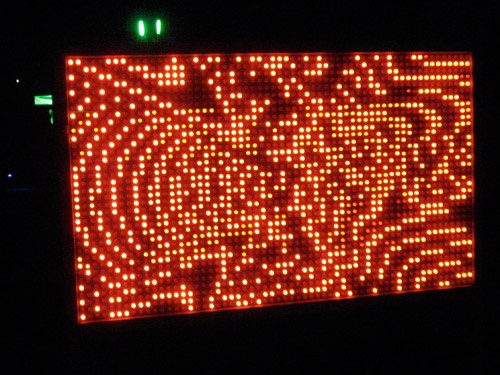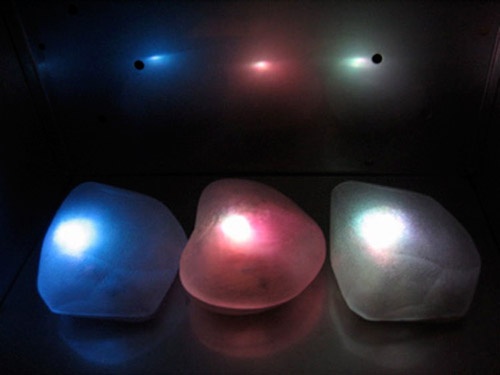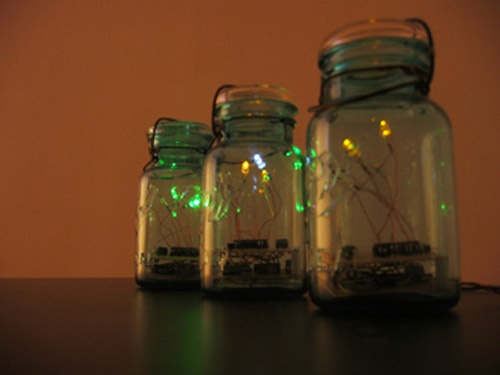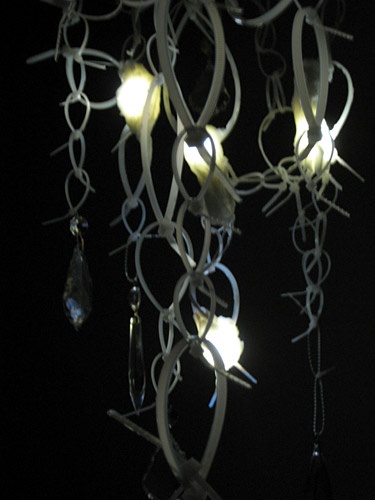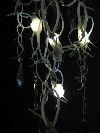Greylock Arts Features Expressive LED Art
An Insider's Perspective on the New Exhibition
By: Matthew Belanger - Nov 14, 2007
Greylock Arts' latest exhibition "LEDs Are Pretty," from November 16 through December 28, opening November 16 from 5:30 to 8:30 PM, is a tribute to an unsung hero of the Electronic Age, the light emitting diode, or LED for short. LEDs are simply semiconductors that create light as electric current travels through them. Unlike incandescent light bulbs which use a burning filament to produce visible light, the light produced by an LED is created by the actual movement of electrons. LEDs are capable of producing visible light in a wide variety of colors as well as invisible light. Experiments resulted in the discovery of the LED in the 1920s, but it remained unperfected until the 1960s, when the right combination of conductive materials was found.
Widespread use of LEDs began in the mid 1970s and their use has increased since then. LEDs are most often found in industrial and electronic applications. They are used mostly to create light, inform, and display feedback. The LED can be found in nearly everything we use to navigate our modern world. They are embedded in traffic lights, electronic displays, remote controls, digital clocks, and an endless array of other electronic devices.
Greylock Arts, at 93 Summer Street, in Adams, Mass. was founded several months ago with a mandate to present work motivated by new media and applications of a broad range of technologies in contemporary art. With its unique focus the gallery hopes to initiate a diverse dialogue that extends the range of art being created and presented in the Northern Berkshires.
Use of the LED by artists dates back to at least the 1970s. The LED is a perfect symbol of our electronic age and, as such, it makes sense for artists to incorporate it into contemporary works of art. The artist Jenny Holzer, who is currently featured with a major installation at the Massachusetts Museum of Contemporary Art, has often used LED based signage to display text in her "Truisms" series, and the late Kevin McCormick was well known for his LED based sculptures.
The concept for Greylock Arts third exhibition "LEDs Are Pretty" came out of a breakfast conversation with one of the artists in the show, Carlyn Maw. She began telling us about an idea for a series she was planning that involved using LEDs to create representations of social networks. She ended her description with, "And you know, LEDs are pretty." This simple declaration became the basis for, and title of, our new exhibition. In this group show we pay tribute to the expressive qualities of the ubiquitous LED.
The five art works on display in our Adams gallery are the product of seven artists. Two artists, Rory Nugent and Leif Krinkle, were part of our last show "Sustainable Energy Art" and return with new works. Leif's "Luscious Electric Delight" a play on LED, is a 48 x 28" display consisting of 2,100 red LEDs. "Luscious Electric Delight" is programmed to create and display algorithmically generated psychedelic patterns. Rory, Minsoo Lee, and Gregory Stringer worked together to produce "Stoneglow" a collection of stone-shaped devices that change color depending on their relationship to one another. The viewer can produce unique color combinations by playfully moving these stones relative to one another thus changing the color of the LEDs embedded inside.
"Fireflies" by John Schimmel are networked LEDs that resemble fireflies caught in mason jars. The trapped fireflies respond to your tapping and wirelessly inform communities of fireflies in other jars about the pattern you've tapped. Carlyn Maw's "Constellations" employs LEDs and gold on canvas to represent social networks through constellation-like patterns. Finally, Miriam Songster's "Chandelier" uses plastic cable ties, Austrian crystal, and white LEDs covered in Crisco shortening to question our notions of the beauty and value of certain materials over others. "Chandelier" will be visible at all times in our gallery's large storefront windows.
"Chandelier" has proven to be our young gallery's most ambitious installation to date. Songster has been working to conceive and build the work over the course of the last several months. She began by collecting crystal from old chandeliers found at antique stores and thrift shops with the hope of building a unique light fixture for her Brooklyn apartment. The project grew as she collected and began experimenting with more materials. Miriam arrived a week before our opening to begin installing. Generally, we have only shown completed works in our gallery, but Miriam's art is often site specific and she wanted to build something special for our unique window displays.
The former Pociask building that houses our gallery is a unique place within the community. Many remember it as a vibrant clothing store with fond memories of special garments purchased here until it closed in the mid-1960s. Younger patrons remember our building as the music store that existed here until the late-1980s where they learned to play guitar or bought albums on vinyl. We feel strongly that through Greylock Arts we honor the heritage of this structure by filling our storefront windows with art to engage the community.
All of the artists will be on hand for our opening reception. The exhibit will run through December 28th and is open Saturdays from 1 – 4 p.m. and by appointment. To arrange an appointment call 413-241-8692 or email info@greylockarts.net. For additional details about the "LEDs Are Pretty" exhibition visit the Greylock Arts website. http://www.greylockarts.net

